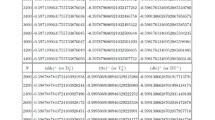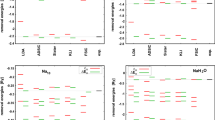Abstract
Incomplete spaces are investigated for solving the Schrödinger equation under the Born–Oppenheimer approximation. It is shown that the Hellmann–Feynman theorem cannot be used for computing the electronic force exerted on a nucleus, when a variational wavefunction with floating centers is used, if multicenter polynomial components are added in order to describe the polarization effects through the chemical bond. This is because the minimum of the potential energy surface is not a stationary point in the direction of the float parameter. Such a failure can be fixed by considering a molecular model with finite size nuclei, as defined herein. The classical electronic force is computed for that model, as compared with the standard point charge approximation, and it is applied to the \({\text {H}_2}^+\) molecular ion. As a result, the former model is found more accurate by several orders of magnitude.
Similar content being viewed by others
References
R.P. Feynman, Forces in molecules. Phys. Rev. 56, 340 (1939)
H. Hellmann, Einführung in die Quantenchemie (Franz Deuticke, Leipzig, 1937)
P. Lazzeretti, R. Zanasi, Connection between the nuclear electric shielding tensor and the infrared intensity. Chem. Phys. Lett. 112, 103–105 (1984)
S.S.M. Dordrecht, in Fundamental World of Quantum Chemistry, vol. III, ed. by E.J. Brändas, E.S. Kryachko (Springer, Netherlands, 2004)
P. Lazzeretti, Forces on the nuclei of a molecule in optical fields. Theor. Chem. Acc. 116, 420–426 (2006)
P. Lazzeretti, R. Zanasi, Theory of nuclear electric shielding in molecules. Phys. Rev. A 24, 1696–1704 (1981)
P. Lazzeretti, R. Zanasi, Calculations of nuclear electric shielding in molecules. Chem. Phys. Lett. 71, 529–533 (1980)
P. Lazzeretti, R. Zanasi, Sum rules related to third-order properties: a numerical check. Chem. Phys. 288, 281–289 (2003)
A. Soncini, V. Bakken, P. Lazzeretti, T. Helgaker, Calculation of electric dipole hypershieldings at the nuclei in the Hellmann–Feynman approximation. J. Chem. Phys. 120, 3142–3151 (2004)
J. Linpiński, Sum rules for nonlinear optical properties of molecules. J. Chem. Phys. Lett. 394, 397–399 (2004)
A. Dalgarno, Atomic polarizabilities and shielding factors. Adv. Phys. 11, 281–315 (1962)
P.W. Langhoff, M. Karplus, R.P. Hurst, Approximations to Hartree–Fock perturbation theory. J. Chem. Phys. 44, 505–514 (1966)
D.F. Tuan, A. Davidz, Different perturbed uncoupled Hartree–Fock (PUCHF) methods for physical properties. II. Dipole shielding factors. J. Chem. Phys. 55, 1294–1299 (1971)
P. Lazzeretti, R. Zanasi, Analytic dipole moment geometric derivatives from nuclear electric shielding in molecules. J. Chem. Phys. 84, 3916–3920 (1984)
R. Zanasi, P. Lazzeretti, Analytic dipole moment geometric derivatives from nuclear electric shielding: II. Application to two-heavy atom molecules. J. Chem. Phys. 85, 5932–5935 (1986)
J. Lipiński, On the consequences of the violation of the Hellmann–Feynman theorem in calculations of electric properties of molecules. Chem. Phys. Lett. 363, 313–318 (2002)
B.M. Deb, The Force Concept in Chemistry (Van Nostrand Reinhold, New York, 1981)
A.C. Hurley, The electrostatic calculation of molecular energies. II. Approximate wave functions and the electrostatic method. Proc. R. Soc. Lond. 226, 179 (1954)
H. Shull, D.D. Ebbing, Floating wave functions for H2 \(+\) and H2. J. Chem. Phys. 28, 866–870 (1958)
M. Geller, A.A. Frost, P.G. Lykos, Distortion of atomic orbitals in molecular orbitals. I. Polarization of the hydrogen atom in H\(_2^+\). J. Chem. Phys. 36, 2693 (1962)
F.M. Fernández, Alternative treatment of separable quantum-mechanical models: The hydrogen molecular ion. J. Chem. Phys. 103, 6581 (1995)
L. Visscher, K.G. Dyall, Dirac—Fock atomic electronic structure calculations using different nuclear charge distributions. At. Data Nucl. Data Tables 67(2), 207–224 (1997)
A.J. Buchmann, E.M. Henley, Intrinsic quadrupole moment of the nucleon. Phys. Rev. C 63, 015202 (2000)
A.J. Buchmann, Nucleon deformation and atomic spectroscopy. Can. J. Phys. 83, 455–465 (2005)
A.J. Buchmann, Non-spherical proton shape and hydrogen hyperfine splitting. Can. J. Phys. 87, 773–783 (2009)
T. Kato, On the eigenfunctions of many-particle systems in quantum mechanics. Commun. Pure Appl. Math. X, 157–177 (1957)
Author information
Authors and Affiliations
Corresponding author
Rights and permissions
About this article
Cite this article
Gutlé, C. Going Beyond the Point Nucleus Approximation to Satisfy the Hellmann–Feynman Theorem: Born–Oppenheimer \({\text {H}}_{\mathbf{2}}^{{\varvec{+}}}\) in the Ground State. Few-Body Syst 58, 119 (2017). https://doi.org/10.1007/s00601-017-1284-4
Received:
Accepted:
Published:
DOI: https://doi.org/10.1007/s00601-017-1284-4




